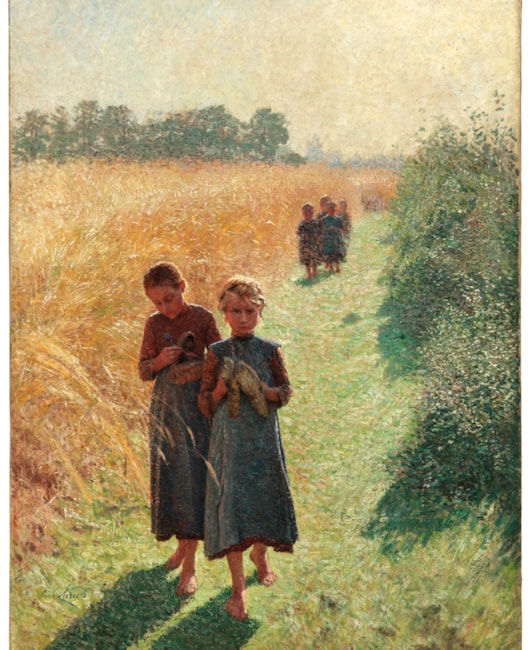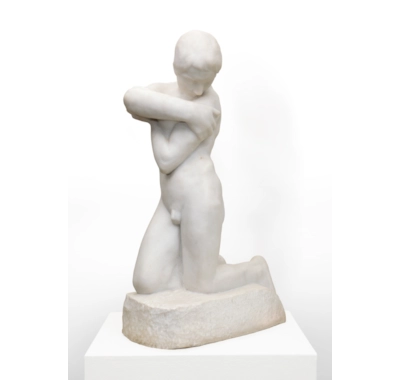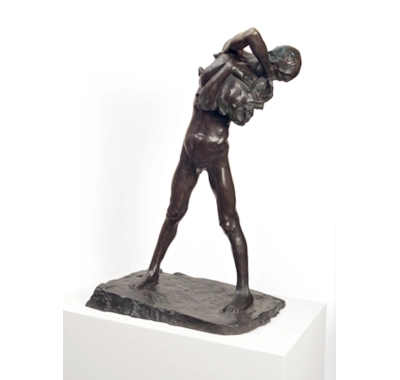Emile Claus
(1849 - 1924)
Return from school / Young girls in the field
1892
Oil on canvas
132 x 99 cm
Signed lower left: Emile Claus
Framed: 150 x 116 cm (59 x 45 ⁵/₈ inches)
Oil on canvas
132 x 99 cm
Signed lower left: Emile Claus
Framed: 150 x 116 cm (59 x 45 ⁵/₈ inches)
Madame G.C., Brussels
Galerie Georges Giroux, Brussels, 1929, no. 28
Mrs F. Soethoudt, Brussels
Guillaume Campo, Antwerp, 1982, no. 25
Galerie Oscar De Vos, Sint-Martens-Latem
Private collection, Belgium
Galerie Georges Giroux, Brussels, 1929, no. 28
Mrs F. Soethoudt, Brussels
Guillaume Campo, Antwerp, 1982, no. 25
Galerie Oscar De Vos, Sint-Martens-Latem
Private collection, Belgium
‘He is a Realist marching towards light’
Painted in 1892, Girls in the Fields is a dazzling example of Claus’s Luminist style. A group of girls, perhaps returning home from school, their clogs, or sabots in hand, and backlit by the golden light of a summer’s afternoon, process along the border of a field of ripe wheat. The expressions of the two leading girls are tenderly and naturalistically observed, while the effects of light and colour clearly show the influence of the French Impressionists, and particularly the work of Claude Monet whose work Claus had seen during his stay in Paris three years earlier, in 1889.
Breaking defiantly with the academic method of his teacher at the Antwerp Academy Nicaise de Keyser, Claus wrote 'Je ne sais pas, je ne veux pas peindre les Grecs et Romains' (‘I don’t know, but I don’t want to paint the Greeks and the Romans’), and after leaving the Academy began painting pictures of everyday peasant life, inspired by the French naturalist Jules Bastien Lepage. From 1883, he settled in Astene, on the banks of the Lys, in an old hunting pavilion which he later converted into his home, Zonneschijn. It was here that, at the encouragement of writer, poet, and champion of peasant life Camille Lemonnier, he began tempering his naturalism with a more colourful and luminous palette.
The present work belongs to the series of large-format paintings Claus embarked on in the 1890s of the peasant community of Flanders, depicting harvesters, communicants, fishermen, and haymakers. In many, the figures are backlit and cast long shadows, testament to Claus’s interest in the effects of light and shadow. However, the light coming from behind also served to heighten the subtle symbolism implicit in these paintings. The sun catching on the girls’ hair adds a quasi-holy aura to their already angelic expressions, making them truly God’s creatures. Like Jean-François and Jules Bastien-Lepage before him, Claus celebrated the honest, innocent, hard-working men, women and children of the local rural community, elevating them high above their humble station in life.
Painted in 1892, Girls in the Fields is a dazzling example of Claus’s Luminist style. A group of girls, perhaps returning home from school, their clogs, or sabots in hand, and backlit by the golden light of a summer’s afternoon, process along the border of a field of ripe wheat. The expressions of the two leading girls are tenderly and naturalistically observed, while the effects of light and colour clearly show the influence of the French Impressionists, and particularly the work of Claude Monet whose work Claus had seen during his stay in Paris three years earlier, in 1889.
Breaking defiantly with the academic method of his teacher at the Antwerp Academy Nicaise de Keyser, Claus wrote 'Je ne sais pas, je ne veux pas peindre les Grecs et Romains' (‘I don’t know, but I don’t want to paint the Greeks and the Romans’), and after leaving the Academy began painting pictures of everyday peasant life, inspired by the French naturalist Jules Bastien Lepage. From 1883, he settled in Astene, on the banks of the Lys, in an old hunting pavilion which he later converted into his home, Zonneschijn. It was here that, at the encouragement of writer, poet, and champion of peasant life Camille Lemonnier, he began tempering his naturalism with a more colourful and luminous palette.
The present work belongs to the series of large-format paintings Claus embarked on in the 1890s of the peasant community of Flanders, depicting harvesters, communicants, fishermen, and haymakers. In many, the figures are backlit and cast long shadows, testament to Claus’s interest in the effects of light and shadow. However, the light coming from behind also served to heighten the subtle symbolism implicit in these paintings. The sun catching on the girls’ hair adds a quasi-holy aura to their already angelic expressions, making them truly God’s creatures. Like Jean-François and Jules Bastien-Lepage before him, Claus celebrated the honest, innocent, hard-working men, women and children of the local rural community, elevating them high above their humble station in life.
1929, Brussels, Galerie George Giroux, no. 29.
1974, Ghent, Museum voor Schone Kunsten, Retrospective Exhibition Emile Claus 1849-1924, no. 49.
1982, Antwerp, Guillaume Campo, no. 25.
1991, Deinze, Museum van Deinze en de Leiestreek, Schilders van het Leieland, no. 144.
2004, Deurle, Museum Dhondt-Dhaenens, In de lente van mijn land. Karel van de Woestijne en Latem, 14.03-25.05.
2009, Ghent, Museum voor Schone Kunsten, Emile Claus and Rural Life, no. 93.
2010-2011, Himeji, City Museum of Art; Tokyo, The Bunkamura Museum of Art; Miyoshi, Okuda Genso Museum, Light of Flanders. Images of a beautiful Belgian village, no. 36.
2013, Himeji, City Museum of Art; Tokyo, Station Gallery; Ishikawa, Prefectural Museum of Art; Hekinan, City Tatsukichi Fuji Museum of Contemporary Art, Emile Claus and Belgian Impressionism, no. 6.
2021, Mechelen, Heilige Geestkapel, Het Kunstuur.
1974, Ghent, Museum voor Schone Kunsten, Retrospective Exhibition Emile Claus 1849-1924, no. 49.
1982, Antwerp, Guillaume Campo, no. 25.
1991, Deinze, Museum van Deinze en de Leiestreek, Schilders van het Leieland, no. 144.
2004, Deurle, Museum Dhondt-Dhaenens, In de lente van mijn land. Karel van de Woestijne en Latem, 14.03-25.05.
2009, Ghent, Museum voor Schone Kunsten, Emile Claus and Rural Life, no. 93.
2010-2011, Himeji, City Museum of Art; Tokyo, The Bunkamura Museum of Art; Miyoshi, Okuda Genso Museum, Light of Flanders. Images of a beautiful Belgian village, no. 36.
2013, Himeji, City Museum of Art; Tokyo, Station Gallery; Ishikawa, Prefectural Museum of Art; Hekinan, City Tatsukichi Fuji Museum of Contemporary Art, Emile Claus and Belgian Impressionism, no. 6.
2021, Mechelen, Heilige Geestkapel, Het Kunstuur.
Catalogue de la Collection de Madame G.C. (Brussels: Galerie Georges Giroux, 1929), no. 29, ill. no. 12 (ill.).
Eeckhout, P., Retrospectieve tentoonstelling Emile Claus 1849-1924, cat. (Gent: MSK, 1974), 49, no. 49.
Bombeke, R. e.a., Schilders van het Leieland, cat. (Deinze: MuDeL, 1991), no. 144.
Boyens, P., Sint-Martens-Latem. Kunstenaarsdorp in Vlaanderen (Tielt: Lannoo, 1992), 535 (ill.).
Ruyters, M., Campo 1897-1997 (Antwerpen: Stefan Campo, 1997), 85, no. 11 (ill.).
De Smet, J. e.a., Emile Claus en het landleven, cat. (Gent: MSK, 2009), 145, 93 (ill.).
Hoozee, R. e.a., Lights of Flanders. Images of a beautiful Belgian village, cat. (Tokyo: The Mainichi Newspapers, 2010), 71, no. 36 (ill.).
De Smet, J. e.a., Emile Claus and Belgian Impressionism, cat. (Kobe: The Kobe Shimbun, 2013), 46, no. 6 (ill.).
Eeckhout, P., Retrospectieve tentoonstelling Emile Claus 1849-1924, cat. (Gent: MSK, 1974), 49, no. 49.
Bombeke, R. e.a., Schilders van het Leieland, cat. (Deinze: MuDeL, 1991), no. 144.
Boyens, P., Sint-Martens-Latem. Kunstenaarsdorp in Vlaanderen (Tielt: Lannoo, 1992), 535 (ill.).
Ruyters, M., Campo 1897-1997 (Antwerpen: Stefan Campo, 1997), 85, no. 11 (ill.).
De Smet, J. e.a., Emile Claus en het landleven, cat. (Gent: MSK, 2009), 145, 93 (ill.).
Hoozee, R. e.a., Lights of Flanders. Images of a beautiful Belgian village, cat. (Tokyo: The Mainichi Newspapers, 2010), 71, no. 36 (ill.).
De Smet, J. e.a., Emile Claus and Belgian Impressionism, cat. (Kobe: The Kobe Shimbun, 2013), 46, no. 6 (ill.).
You May Also Like
Emile Claus
(1849 - 1924)
Return from school / Young girls in the field








